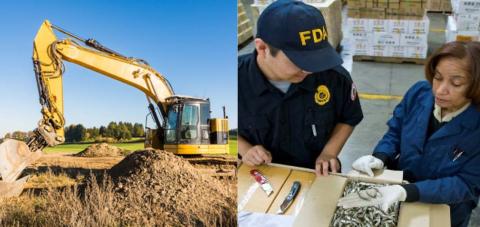Response to and recovery from a food incident includes both short- and long-term actions to protect the public from the food incident, restore public confidence in the safety of the food supply, and ensure the future safety and availability of food products. Eliminating any ongoing threat is critical for recovery. Therefore, recovery activities for food incidents include:
- Inspecting/investigating regulated facilities to collect and analyze samples from implicated products.
- Destroying or reconditioning products.
- Decontamination and sanitization of the food production facility(s) that may have processed or was implicated in the adulterated food product(s).
- Supporting facilities that manufacture/process, pack, or hold food for human or animal consumption during the incident.
- Assisting industry in understanding and complying with regulations post-incident.
Under normal conditions, a food incident can be expected to cause only intermittent shortages of the affected product on the store shelves, and not a long-term food shortage. However, panic buying, stockpiling, and hoarding by the public can affect product availability. A food incident may also have cascading effects beyond the direct impacts to industry, including economic losses to related industries, economic losses to surrounding communities, trade restrictions/closures, and public health impacts. For example, if a supply relationship is suspended due to a chemical emergency, the customer will seek other suppliers and regaining lost markets may be difficult due to the newly entrenched competition. Acts of terrorism (threatened or actual) can severely harm agricultural production and domestic agricultural markets by undermining confidence in the safety of the food supply, international export markets, and the economic security of the greater agricultural community. Larger attacks could even threaten the economic stability and national security of the United States. Therefore, economic recovery needs following a chemical food incident may be wide-ranging and could encompass wide swaths of industries associated with food and agriculture activities.
Eliminating any ongoing threats to food and agriculture systems is critical for achieving recovery outcomes.

In many cases, industry will coordinate the decontamination, sanitization, and other remediation actions needed to resume normal business operations as well as immediately reroute supply chains to minimize the effects on demand for the affected commodity. In some cases, however, contamination may be a long-term barrier to continuing activities at that site; for example, an environmentally persistent chemical may remain in soil or sediments for an extended time, preventing crops or fisheries raised there from reaching the market for years to come. However, if the cost of recovery activities and the extent of contamination are high, industry may opt to close a facility or business instead of managing high remediation costs. These decisions may result in the affected business or facility closing, localized economic hardship including job loss and economic losses to associated businesses, and abandoned contaminated facilities that pose a threat to human, animal, and environmental health.

